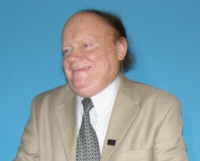Signal encapsulation principle Ⓢ
Zbigniew A. Nowacki
Lodz, Poland, September 2011
 In Quantum
Nonlocality... the signal encapsulation
principle Ⓢ
has been formulated in the simplest and most general way:
In Quantum
Nonlocality... the signal encapsulation
principle Ⓢ
has been formulated in the simplest and most general way:
A signal transmitted by one observer will be received with positive probability by another if and only if its speed measured by the latter would be nonnegative and finite.
In my article I dealt mainly with the transfer of information, whereas a few days
ago it was announced that at the Gran Sasso National Laboratory
an Italian-French group had observed neutrinos moving faster than c (with a speed
of about 1.000025c). In this connection, I would like to state that the
principle Ⓢ
(in conjunction with the fact that in quantum physics particles do not have
trajectories) protects us against all contradictions implied by superluminal signals,
regardless of whether they transmit energy or information only. Lorentz transformations can be
normally used in science, and time travel (that has been recently considered even by serious scholars)
remains a favorite subject for writers of science fiction.
It is unfortunate that some physicists do not let their colleagues and the general public refer to this principle. For now there would not be all this confusion and disorientation if my papers introducing Ⓢ had been published. And even if the reports of Gran Sasso have not been confirmed, it is worth paying attention to a philosophical aspect. For it turns out that by introducing an axiom (suitable, since the so-called reinterpretation principle does not work) one can remove contradictions harassing physicists using a naive understanding of signals. This is a sophisticated tool similar to the solution of the paradox of 'the set of all sets' in mathematics and some conceptions (data encapsulation) known from computer science.
One more thing needs to be said. Nobody should maintain that the researchers of Gran Sasso have refuted Einstein's theory, because this was earlier done by the author of the text, who already in 2005 (exactly on the centenary of the rise of special relativity theory) presented well documented proposals for appropriate experiments. One would like to believe that sometime honest people will confirm this fact.
Cable fault
Lodz, Poland, April 2012
It has been announced that two leaders of the research group at Gran Sasso resigned. The reason given was a bad atmosphere in the team. Earlier, it was reported that causes of erroneous measurements had been found (a fiber-optic cable had been poorly fitted). However, I think (although the results of Gran Sasso were actually incorrect) that this is not the end of the story, and in this area we will still witness events incomprehensible to experimenters. They will still argue.
Speaking more seriously, I suppose that superluminal long-distance energy transfer will be, sooner or later, accomplished, since on the ground of quantum physics this does not lead to contradictions. It is even possible that this already happened, but it was not properly interpreted due to the lack of appropriate theory. (Astronomers can rightly guess I mean the explosion of a supernova in 1987. By repeatedly applying the uncertainty principle we will be able to unravel its surprising mystery, and even to specify the names of humans who were the first to observe particles moving at superluminal speeds.)